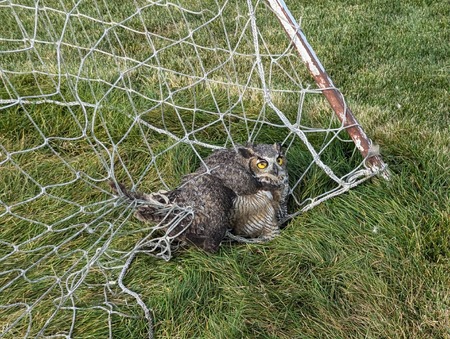
Good Natured: A Great Horned Owl Rescue
The call came in at 8 a.m. on a Friday morning, just as I was sitting down to tell last week's story—the one about Snappy, the snapping turtle that got tangled up in fishing line that had been left behind.
On the phone was Ryan Solomon, our lead restoration ecologist. He had received a call from Bill Thomas, our turf supervisor, who had gotten a call from Gary Blum, a member of his field staff. Gary was mowing at James O. Breen South, a slice of park along Peck Road south of Route 38, when he happened to notice that one of the soccer goals had netted something other than a soccer ball. Thoroughly entangled in the north goal on Field 2 was…a great horned owl.
Make that a greatly agitated great horned owl. Likely in pursuit of prey, the bird had flown into the base of the goal and soon found itself trapped. The cords of the net were wound around the owl's wing, and no amount of flapping could shake them. If anything, they got tighter every time the bird tried to move.
Ryan had also called our supervisor, Chris Gingrich, and the three of us converged on the soccer goal. Armed with scissors, plant pruners, thick leather gloves and a heavy blanket, we set to work. Ryan covered the bird's head and kept him still while Chris and I snipped away at the netting.
Luckily none of the cords were around the owl's neck, which was a situation we'd faced when this same thing happened a few years ago. In another turn of good fortune, the owl's wing feathers were a bit ruffled but not broken, and once freed his wing folded nicely back into place. No broken bones either. Phew!
After maybe 10 seconds of regaining his composure, and a glare that said a thousand words (most of them unprintable) the owl took off toward the tree line to the west, where it could regroup and regain its cool bird-of-prey composure.
On the surface it might seem like Snappy and Owly are two completely different types of animals that happen to have encountered some trouble. But you don't have to dig too much deeper to see that both animals' misfortunes were directly related to human activities. This got me to wondering…just how big of a problem do humans cause for wildlife?
Even though we're not a wildlife rehabilitation facility, our Hickory Knolls Discovery Center gets calls throughout the year for critters that need help. Turtles get hit by cars, birds fly into windows, dogs (and cats) find bunny nests. We typically send these requests to our local rehabbers at Anderson Humane and Kane Area Rehabilitation & Education (KARE) for Wildlife, which in turn keep records of the hundreds of cases they handle each year.
So I know we humans can cause big problems for our little friends. But still the question nagged at me...how widespread are the threats humans pose to wildlife?
That's when I took to the internet, using a key search term: anthropogenic. It's a word that means “ of, relating to, or resulting from the influence of human beings on nature."
As luck would have it, an analysis of animals admitted for rehabilitation used that exact word in the title. Even better, it was published fairly recently—just about a year ago. Compiled by researchers affiliated with Boston University, “Wildlife rehabilitation records reveal impacts of anthropogenic activities on wildlife health" took a deep dive into the records kept by 94 wildlife rehab facilities across the United States and Canada.
In an effort that makes my head spin just thinking about it, the study authors analyzed 674,320 digitized records documenting the cases of more than 1,100 different types of animals.
The study authors wrote, “Overall, Human Disturbance was the most common reason for animals to be admitted (39.8 % of cases), followed by Orphaned (20.1 %), Unknown or Other (17.1 %), Injured or Sick (15.0 %), Natural Disturbance (4.7 %), Infectious Disease (2.8 %), and Toxicants (0.6 %). Of the Human Disturbance category, vehicle collisions were the most common reason for admittance (12.0 %). Vehicle collisions were highest from May to July and disproportionately affected reptiles."
While all the data analyzed pertained to wildlife in trouble, the paper didn't focus exclusively on gloom and doom. In fact the ultimate goal of the study was to be able to make recommendations that can help make things better for animals and humans alike. The authors noted that improvements like new overpasses and underpasses and roadside vegetation management can help reduce vehicle collisions; turning lights off at night can help cut down on window crashes.
Bringing this back to a local level, picking up stray fishing line and keeping a close watch on sports nets (soccer but also lacrosse, volleyball and badminton too) and taking them down when not in use are other great steps to take, now that we're aware they're a problem. Because, to paraphrase an old quote, now that we know better, we can do better when it comes to our wild neighbors.
Pam Otto is the outreach ambassador for the St. Charles Park District. She can be reached at potto@stcparks.org.

